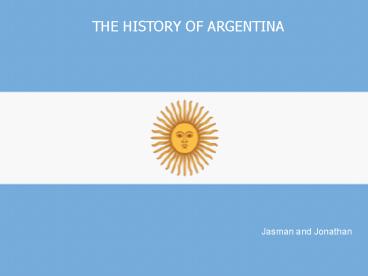The History of Argentina - PowerPoint PPT Presentation
Title:
The History of Argentina
Description:
THE HISTORY OF ARGENTINA Jasman and Jonathan Important dates The land of Argentina was found in 1538 by Domingo Martinez de Irala. The city of Buenos Aires was ... – PowerPoint PPT presentation
Number of Views:424
Avg rating:3.0/5.0
Title: The History of Argentina
1
THE HISTORY OF ARGENTINA
Jasman and Jonathan
2
Important dates
- The land of Argentina was found in 1538 by
Domingo Martinez de Irala. - The city of Buenos Aires was founded in 1580.
- War breaks out between rebels and the Colonial
Government of Spain in 1810 with the revolution
of May. - Independence Declared July 9, 1816 by the
congress of Tucuman. - Great Britain officially recognized Argentine
independence in 1825 with signing of the Treaty
of of Friendship, commerce, and Navigation. - 1829 Juan Manuel de Rosas was declared Governor
of Buenos Aires.
3
Economics
- In 1870, a wave of foreign investment from Europe
led to the development of modern agriculture and
helped strengthen Argentina's economy. - Cattle ranches and sheep farms makes Argentinas
biggest export of food. - The production of Cattle meat and the export of
it helped give rise to Argentinas dominance in
South Americas economy. - Buenos Aires became the main trading port of
Argentina
4
Politics
- Buenos Aires became the capital of Argentina.
- The first president of Argentina in 1826 was
Bernardino Rivadavia. - Shortly after he resigned Civil War broke out.
- In 1829 a new president arose. Juan Manuel de
Rosas was elected for a three year term as a
Federalist. Later he became known as the savior
of Argentina. - In 1835 he became the first dictator of
Argentina.
5
Social History and Culture
- Argentinas main religion is and was
Roman-Catholic. - Most Argentines are mostly of European descent.
- Between the 1850s and 1940, more than 3.5 million
immigrants arrived in Argentina. - Argentines are fiercely nationalistic and also
have a sense of individuality that derives from
the mythical figure of the Gaucho. - Argentines believe in being open, frank, and
direct, but also take pride in being tactful and
diplomatic. - Goat Corral (Fernando Fader, 1926).
6
IMPORTANT PEOPLE
- Simon Bolivar Liberator of South America.
- Jose de San Martin the Liberator of Argentina.
- Juan Manuel de Rosas Governor of Buenos Aires
Province, and a dictator. Ruled from 1829-1832,
then 1835-1852. - Bernardino Rivadavia the first president of
Argentina Feb 8,1826- July 7,1827. - Justo Jose de Urquiza the man who defeated Rosas
and became the third president. From March 5,
1854- March 4, 1860.
7
Background
- The Spanish Empire established the Viceroyalty of
the Rio de la Plata in 1776. - Viceroyalty was short-lived because lack of
internal cohesion among the many regions and the
lack of the Crown support. - Napoleons invasion of Spain, which brought the
Spanish crown down in the mainland Europe, but
not in the rest of the colonies. - The Creoles that did go to Europe brought back
ideas and ideals of the Enlightenment thinking.
8
The building of a Nation post Nation
- After independence, Argentina had serve
political infighting among those vying for power.
- One of the nations main exports such as the
salted beef helped provide Argentina with major
contracts with other nations. - After many years under a dictatorship of the
newly established government we see that new
rebellions break out against the regime. - As with the progression of Argentinas newly
formed government. It goes through a ever
changing forms. - An to consolidate their strength in South America
Argentina had gone to war over territory, wealth,
and power.
9
Current statuses
- Argentina has gone through many Coups that has
brought it to its knees with militaristic
dictatorships and corrupt officials, also
military juntas. - Main export is still beef production that comes
from the ranches. - Argentinas official population estimate of 2009
is 40,134,425. - It has one of the best economies of south
America. - It is still heavily almost 90 of the population
is still Roman catholic. - The form of government that it has now is a
democracy.
10
Bibliography
- Lewis K. Daniel. The History of Argentina.
Connecticut Greenwood Press, 2001. This source
helped us with the timeline and charts. - A History of the Argentine Republic. London
Cambridge at the UP, 1931. Print. This source
helped us find the beginning history of
Argentina. - A Brief History of Argentina. New York
University of Texas at Austin, 2003. Print. This
source helped us with finding out the main
exports of Argentina. - Foster, David William. Culture and customs of
Argentina. Westport, Conn Greenwood, 1998.
Print. This source was helpful because it helped
us with the Argentinean culture. - Shumway, Nicolas. Invention of Argentina.
Berkeley University of California, 1991. Print.
This source helped us with finding Argentina's
nation building. - "Argentina -." Wikipedia, the free encyclopedia.
Web. 03 Nov. 2009. lthttp//en.wikipedia.org/wiki/A
rgentinagt. This website helped us with current
statuses.






























![[PDF]❤️DOWNLOAD⚡️ Buenos Aires Travel Guide 2023 And Beyond: Discover the Best of Argentina's Vi PowerPoint PPT Presentation](https://s3.amazonaws.com/images.powershow.com/10132773.th0.jpg?_=202409180612)
![[DOWNLOAD]⚡️PDF✔️ Buenos Aires Travel Guide 2023 And Beyond: Discover the Best of Argentina's Vi PowerPoint PPT Presentation](https://s3.amazonaws.com/images.powershow.com/10132774.th0.jpg?_=202409180612)